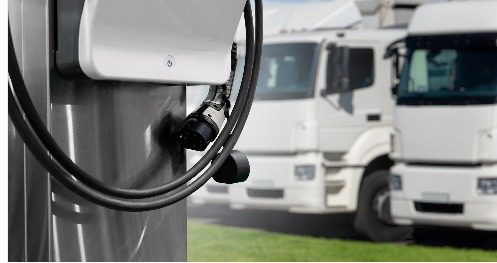Toolkit for electrifying trucking fleets

Kelbe Goupil & Kevin Emerson from Utah Clean Energy
Although medium- and heavy-duty vehicles (MHDV) account for a mere 5% of the vehicles on the road, they are responsible for 25% of total greenhouse gas (GHG) emissions from the transportation sector and about 45% of total nitrogen oxide (NOx) emissions. It is historically disadvantaged communities that face the brunt of this pollution due to being located near interstate corridors and freight centers.
The good news is that the transportation sector is moving away from polluting fossil fuels through electrification.
Through the Inflation Reduction Act and the Bipartisan Infrastructure Law, the federal government has invested $245 billion into electric vehicles, batteries, and charging stations, with $1 billion specifically allocated for clean heavy-duty vehicles. In addition to federal investments, states are taking action to accelerate the electrification of MHDVs through clean truck incentive programs and clean truck rules and regulations, such as the Advanced Clean Trucks rule and the Heavy-Duty Omnibus rule. Additionally, states are expanding access to charging along highways through the National Electric Vehicle Infrastructure program.
The market is responding to and driving this shift as well. The electrification of the transportation sector has historically been concentrated in the passenger vehicle market, but in recent years, electric medium- and heavy-duty vehicles have become increasingly available. The number of available electric MHDV models has grown by 33% in the last two years, with transit buses, medium-step vans, and heavy-duty trucks making up the largest addition of vehicle types available. The applications for electrification are also expanding as technology advances, leading to longer ranges, lighter batteries, more charging infrastructure, and a wider variety of vehicle and equipment types.
To put it simply, there has never been a better time to transition our fleets to electric. The process for electrification can be complex, and there are many resources available that can help MHDV fleets successfully go electric. Utah Clean Energy developed a custom toolkit with a compilation of resources and tools for operators and managers of MHDV fleets. There are some key elements within the fleet electrification process that all fleet managers will want to think through, including:
- Identifying the best vehicles and sites for electrification,
- coordinating with the utility,
- securing funding and other resources to support the project,
- procuring vehicles,
- installing charging infrastructure,
- and training and supporting drivers.
The toolkit contains resources on fleet analysis, including tools for estimating the NOx, particulate matter, and GHG emissions of alternative fuel MHDV vehicles, total cost of ownership, and side-by-side comparisons of multiple vehicle models. Fleet managers can utilize available tools to calculate results for multiple project types to determine how to prioritize which vehicles to electrify and when. The toolkit also provides links to all of the currently available incentives for MHDV electrification, including charging infrastructure.
Fleets are encouraged to take advantage of the wealth of information and guidance available to stay current on new opportunities for electrification. Without a doubt, the electric MHDV market is growing rapidly — one analysis estimates that 66% of new MHDVs will be all electric by 2032! As we look to the future, we can anticipate that this segment of the transportation sector will continue to innovate and electrify, reducing GHG emissions and cleaning up our air.


